Optimization of Ultrasound-Assisted Extraction and Structural Characterization of the Polysaccharide from Pumpkin (Cucurbita moschata) Seeds
Abstract
:1. Introduction
2. Results and Discussion
2.1. Single Factor Tests of UAE
2.1.1. Effect of Different Extraction Time on the Yield of PSP
2.1.2. Effect of Different Extraction Temperature on the Yield of PSP
2.1.3. Effect of Different Ultrasonic Power on the Yield of PSP
2.1.4. Effect of Different Liquid to Solid Ratios on the Yield of PSP
2.2. Optimization of the Yield of PSP by RSM
2.2.1. Statistical Analysis and Model Fitting
2.2.2. Diagnostics of Model Adequacy
2.2.3. Analysis of Response Surfaces
2.2.4. Validation of the Predictive Models
2.3. Purification and Preliminary Characterisation of PSP-1
2.4. FT-IR Spectrum Analysis of PSP-1
2.5. Periodate Oxidation and Smith Degradation Analysis
2.6. Analysis of NMR
2.7. SEM Analysis
3. Materials and Methods
3.1. Materials
3.2. Extraction of PSP
3.3. Single Factor Experiments of UAE
3.4. Experimental Design of RSM
3.4.1. Optimization of UAE by RSM
3.4.2. Verification of Predictive Model
3.5. Purification and Isolation of PSP-1
3.6. Structural Characterization of PSP-1
3.6.1. Determination of Molecular Weight
3.6.2. Analysis of Monosaccharide Composition
3.6.3. Infrared Analysis
3.6.4. Periodate Oxidation and Smith Degradation
3.6.5. Nuclear Magnetic Resonance (NMR) Spectroscopy
3.6.6. SEM Analysis
3.7. Statistical Analysis
4. Conclusions
Author Contributions
Acknowledgments
Conflicts of Interest
References
- Jiao, J.; Li, Z.G.; Gai, Q.Y.; Li, X.J.; Wei, F.Y.; Fu, Y.J.; Ma, W. Microwave-assisted aqueous enzymatic extraction of oil from pumpkin seeds and evaluation of its physicochemical properties, fatty acid compositions and antioxidant activities. Food Chem. 2014, 147, 17–24. [Google Scholar] [CrossRef] [PubMed]
- Stevenson, D.G.; Eller, F.J.; Wang, L.; Jane, J.L.; Wang, T.; Inglett, G.E. Oil and tocopherol content and composition of pumpkin seed oil in 12 cultivars. J. Agric. Food Chem. 2007, 55, 4005–4013. [Google Scholar] [CrossRef] [PubMed]
- Xanthopoulou, M.N.; Nomikos, T.; Fragopoulou, E.; Antonopoulou, S. Antioxidant and lipoxygenase inhibitory activities of pumpkin seed extracts. Food Res. Int. 2009, 42, 641–646. [Google Scholar] [CrossRef]
- Saavedra, M.J.; Aires, A.; Dias, C.; Almeida, J.A.; De Vasconcelos, M.C.B.M.; Santos, P.; Rosa, E.A. Evaluation of the potential of squash pumpkin by-products (seeds and shell) as sources of antioxidant and bioactive compounds. J. Food Sci. Technol. 2015, 52, 1008–1015. [Google Scholar] [CrossRef] [PubMed]
- Maria, I.I.; Muhamad, I.; Caryn, A.S.D. Development of immunonutrient from pumpkin (Cucurbita moschata Duchense Ex. Lamk.) seed. Procedia Chem. 2014, 13, 105–111. [Google Scholar] [CrossRef]
- Shao, Q.S.; Deng, Y.M.; Shen, H.J.; Fang, H.L.; Zhao, X.F. Optimization of polysaccharides extraction from Tetrastigma hemsleyanum Diels et Gilg using response surface methodology. Int. J. Biol. Macromol. 2011, 49, 958–962. [Google Scholar] [CrossRef] [PubMed]
- Fan, L.P.; Ding, S.H.; Ai, L.Z.; Deng, K.Q. Antitumor and immunomodulatory activity of water-soluble polysaccharide from Inonotus obliquus. Carbohydr. Polym. 2012, 90, 870–874. [Google Scholar] [CrossRef] [PubMed]
- Suresh, V.; Senthilkumar, N.; Thangam, R.; Rajkumar, M.; Anbazhagan, C.; Rengasamy, R.; Gunasekaran, P. Separation, purification and preliminary characterization of sulfated polysaccharides from Sargassum plagiophyllum and its in vitro anticancer and antioxidant activity. Process Biochem. 2013, 48, 364–373. [Google Scholar] [CrossRef]
- Yang, W.F.; Wang, Y.; Li, X.P.; Yu, P. Purification and structural characterization of Chinese yam polysaccharide and its activities. Carbohydr. Polym. 2015, 117, 1021–1027. [Google Scholar] [CrossRef] [PubMed]
- Liu, J.; Shang, F.; Yang, Z.; Wu, M.Y.; Zhao, J.H. Structural analysis of a homogeneous polysaccharide from Achatina fulica. Int. J. Biol. Macromol. 2017, 98, 786–792. [Google Scholar] [CrossRef] [PubMed]
- Freitas, F.; Alves, V.D.; Carvalheira, M.; Costa, N.; Oliveira, R.; Reis, M.A.M. Emulsifying behaviour and rheological properties of the extracellular polysaccharide produced by Pseudomonas oleovorans grown on glycerol byproduct. Carbohydr. Polym. 2009, 78, 549–556. [Google Scholar] [CrossRef]
- Maran, J.P.; Priya, B. Ultrasound-assisted extraction of polysaccharide from Nephelium lappaceum L. fruit peel. Int. J. Biol. Macromol. 2014, 70, 530–536. [Google Scholar] [CrossRef] [PubMed]
- Ponmurugan, K.; Al-Dhabi, N.A.; Maran, J.P.; Karthikeyan, K.; Moothy, I.G.; Sivarajasekar, N.; Manoj, J.J.B. Ultrasound assisted pectic polysaccharide extraction and its characterization from waste heads of Helianthus annus. Carbohydr. Polym. 2017, 173, 707–713. [Google Scholar] [CrossRef] [PubMed]
- Xie, J.H.; Shen, M.Y.; Xie, M.Y.; Nie, S.P.; Chen, Y.; Li, C.; Huang, D.F.; Wang, Y.X. Ultrasonic-assisted extraction, antimicrobial and antioxidant activities of Cyclocarya paliurus (Batal.) Iljinskaja polysaccharides. Carbohydr. Polym. 2012, 89, 177–184. [Google Scholar] [CrossRef] [PubMed]
- Yolmeh, M.; Najafi, M.B.H.; Farhoosh, R. Optimisation of ultrasound-assisted extraction of natural pigment from annatto seeds by response surface methodology (RSM). Food Chem. 2014, 155, 319–324. [Google Scholar] [CrossRef] [PubMed]
- Wang, S.P.; Dong, X.F.; Tong, J.M. Optimization of enzyme-assisted extraction of polysaccharides from alfalfa and its antioxidant activity. Int. J. Biol. Macromol. 2013, 62, 387–396. [Google Scholar] [CrossRef] [PubMed]
- Zhu, Y.; Li, Q.; Mao, G.H.; Zou, Y.; Feng, W.W.; Zheng, D.H.; Wang, W.; Zhou, L.L.; Zhang, T.X.; Yang, J.; et al. Optimization of enzyme-assisted extraction and characterization of polysaccharides from Hericium erinaceus. Carbohydr. Polym. 2014, 101, 606–613. [Google Scholar] [CrossRef] [PubMed]
- Wang, L.B.; Cheng, L.; Xu, Y.Q.; Wang, T.H.; Li, L.B.; Wang, H.S. Extraction technology optimization and antioxidant activity of polysaccharides from pumpkin seeds. Trans. Chin. Soc. Agric. Eng. 2016, 32, 284–290. [Google Scholar] [CrossRef]
- Wang, L.B.; Xu, Y.Q.; Yu, Z.Y.; Wang, T.H.; Li, L.B. Ethanol fractional precipitation and ultrasonic modification of pumpkin polysaccharides. Trans. Chin. Soc. Agric. Mach. 2015, 46, 215–220. [Google Scholar] [CrossRef]
- Wang, L.B.; Liu, F.C.; Wang, A.X.; Yu, Z.Y.; Xu, Y.Q.; Yang, Y. Purification, characterization and bioactivity determination of a novel polysaccharide from pumpkin (Cucurbita moschata) seeds. Food Hydrocoll. 2017, 66, 357–364. [Google Scholar] [CrossRef]
- Zhao, C.; Li, X.; Miao, J.; Jing, S.; Li, X.; Huang, L.; Gao, W. The effect of different extraction techniques on property and bioactivity of polysaccharides from Dioscorea hemsleyi. Int. J. Biol. Macromol. 2017, 102, 847–856. [Google Scholar] [CrossRef] [PubMed]
- Liu, Y.; Gong, G.L.; Zhang, J.; Jia, S.Y.; Li, F.; Wang, Y.Y.; Wu, S.H. Response surface optimization of ultrasound-assisted enzymatic extraction polysaccharides from Lycium barbarum. Carbohydr. Polym. 2014, 110, 278–284. [Google Scholar] [CrossRef] [PubMed]
- Zhang, T.T.; Lu, C.L.; Jiang, J.G.; Wang, M.; Wang, D.M.; Zhu, W. Bioactivities and extraction optimization of crude polysaccharides from the fruits and leaves of Rubus chingii Hu. Carbohydr. Polym. 2015, 130, 307–315. [Google Scholar] [CrossRef] [PubMed]
- Zhong, K.; Wang, Q. Optimization of ultrasonic extraction of polysaccharides from dried longan pulp using response surface methodology. Carbohydr. Polym. 2010, 80, 19–25. [Google Scholar] [CrossRef]
- Yan, L.Y.; Yu, C.H.; Chen, J.; Li, X.X.; Wang, W.; Li, S.Q. Ultrasonic-assisted extraction optimized by response surface methodology, chemical composition and antioxidant activity of polysaccharides from Tremella mesenterica. Carbohydr. Polym. 2011, 83, 217–224. [Google Scholar] [CrossRef]
- Yan, J.K.; Wang, Y.Y.; Ma, H.L.; Wang, Z.B. Ultrasonic effects on the degradation kinetics, preliminary characterization and antioxidant activities of polysaccharides from Phellinus linteus mycelia. Ultrason. Sonochem. 2016, 29, 251–257. [Google Scholar] [CrossRef] [PubMed]
- Zhu, Z.Y.; Pang, W.; Li, Y.Y.; Ge, X.R.; Chen, L.J.; Liu, X.C.; Lv, Q.; Dong, G.L.; Liu, A.J.; Zhang, Y.M. Effect of ultrasonic treatment on structure and antitumor activity of mycelial polysaccharides from Cordyceps gunnii. Carbohydr. Polym. 2017, 114, 12–20. [Google Scholar] [CrossRef] [PubMed]
- Wu, X.Y.; Mao, G.H.; Fan, Q.Y.; Zhao, T.; Zhao, J.L.; Li, F.; Yang, L.Q. Isolation, purification, immunological and anti-tumor activities of polysaccharides from Gymnema sylvestre. Food Res. Int. 2012, 48, 935–939. [Google Scholar] [CrossRef]
- Yu, Z.Y.; Liu, L.; Xu, Y.Q.; Wang, L.B.; Teng, X.; Li, X.G.; Li, X.J.; Dai, J. Characterization and biological activities of a novel polysaccharide isolated from raspberry (Rubus idaeus L.) fruits. Carbohydr. Polym. 2015, 132, 180–186. [Google Scholar] [CrossRef] [PubMed]
- Cui, G.T.; Zhang, W.X.; Wang, Q.J.; Zhang, A.M.; Mu, H.B.; Bai, H.J.; Duan, J.Y. Extraction optimization, characterization and immunity activity of polysaccharides from Fructus Jujubae. Carbohydr. Polym. 2014, 111, 245–255. [Google Scholar] [CrossRef] [PubMed]
- Wang, F.X.; Wang, W.; Huang, Y.L.; Liu, Z.W.; Zhang, J. Characterization of a novel polysaccharide purified from a herb of Cynomorium songaricum Rupr. Food Hydrocoll. 2015, 47, 79–86. [Google Scholar] [CrossRef]
- Zha, Z.; Wang, S.Y.; Chu, W.; Lv, Y.; Kan, H.; Chen, Q.; Zhong, L.; Yue, L.; Xiao, J.; Wang, Y.; et al. Isolation, purification, structural characterization and immunostimulatory activity of water-soluble polysaccharides from Lepidium meyenii. Phytochemistry 2018, 147, 184–193. [Google Scholar] [CrossRef] [PubMed]
- Bosco, M.; Miertus, S.; Dentini, M.; Segre, A.L. The structure of gellan indilute aqueous solution. Biopolymers 2000, 54, 115–126. [Google Scholar] [CrossRef]
- Wang, Y.; Wei, X.L.; Wang, F.H.; Xu, J.J.; Tang, X.Z.; Li, N.Y. Structural characterization and antioxidant activity of polysaccharide from ginger. Int. J. Biol. Macromol. 2018, 111, 862–869. [Google Scholar] [CrossRef] [PubMed]
- Xu, X.B.; Gu, Z.X.; Liu, S.; Gao, N.; He, X.Z.; Xin, X. Purification and characterization of a glucan from Bacillus Calmette Guerin, and the antitumor activity of its sulfated derivative. Carbohydr. Polym. 2015, 128, 138–146. [Google Scholar] [CrossRef] [PubMed]
- Liu, W.; Lu, W.S.; Chai, Y.; Liu, Y.M.; Yao, W.B.; Gao, X.D. Preliminary structural characterization and hypoglycemic effects of an acidic polysaccharide SERP1 from the residue of Sarcandra glabra. Carbohydr. Polym. 2017, 176, 140–151. [Google Scholar] [CrossRef] [PubMed]
- Li, Q.M.; Wang, J.F.; Zha, X.Q.; Pan, L.H.; Zhang, H.L.; Luo, J.P. Structural characterization and immunomodulatory activity of a new polysaccharide from jellyfish. Carbohydr. Polym. 2017, 159, 188–194. [Google Scholar] [CrossRef] [PubMed]
- Liu, J.; Zhao, Y.P.; Wu, Q.X.; John, A.; Jiang, Y.M.; Yang, J.L.; Liu, H.L.; Yang, B. Structure characterisation of polysaccharides in vegetable “okra” and evaluation of hypoglycemic activity. Food Chem. 2018, 242, 211–216. [Google Scholar] [CrossRef] [PubMed]
- Liu, W.; Liu, Y.M.; Zhu, R.; Yu, J.P.; Lu, W.S.; Pan, C.; Yao, W.B.; Gao, X.D. Structure characterization, chemical and enzymatic degradation, and chain conformation of an acidic polysaccharide from Lycium barbarum L. Carbohydr. Polym. 2016, 147, 114–124. [Google Scholar] [CrossRef] [PubMed]
- Li, X.Y.; Lu, W.; Wang, Z.Y. Structural characterization and antioxidant activity of polysaccharide from Hohenbuehelia serotina. Int. J. Biol. Macromol. 2017, 98, 59–66. [Google Scholar] [CrossRef] [PubMed]
- Lott, J.A.; Stephan, V.A.; Pritchard, K.A. Evaluation of the Coomassie Brilliant Blue G-250 method for urinary protein. Clin. Chem. 1983, 29, 1946–1950. [Google Scholar] [PubMed]
- Kintner, P.K.; Buren, J.P. Carbohydrate interference and its correction in pectin analysis using the m-hydroxydiphenyl method. J. Food Sci. 1982, 47, 756–759. [Google Scholar] [CrossRef]
- Huang, H.D.; Wu, M.M.; Yang, H.P.; Li, X.Y.; Ren, M.N.; Li, G.Q.; Ma, T. Structural and physical properties of sanxan polysaccharide from Sphingomonas sanxanigenens. Carbohydr. Polym. 2016, 144, 410–418. [Google Scholar] [CrossRef] [PubMed]
Sample Availability: Samples of crude polysaccharides and PSP-1 are available from the authors. |
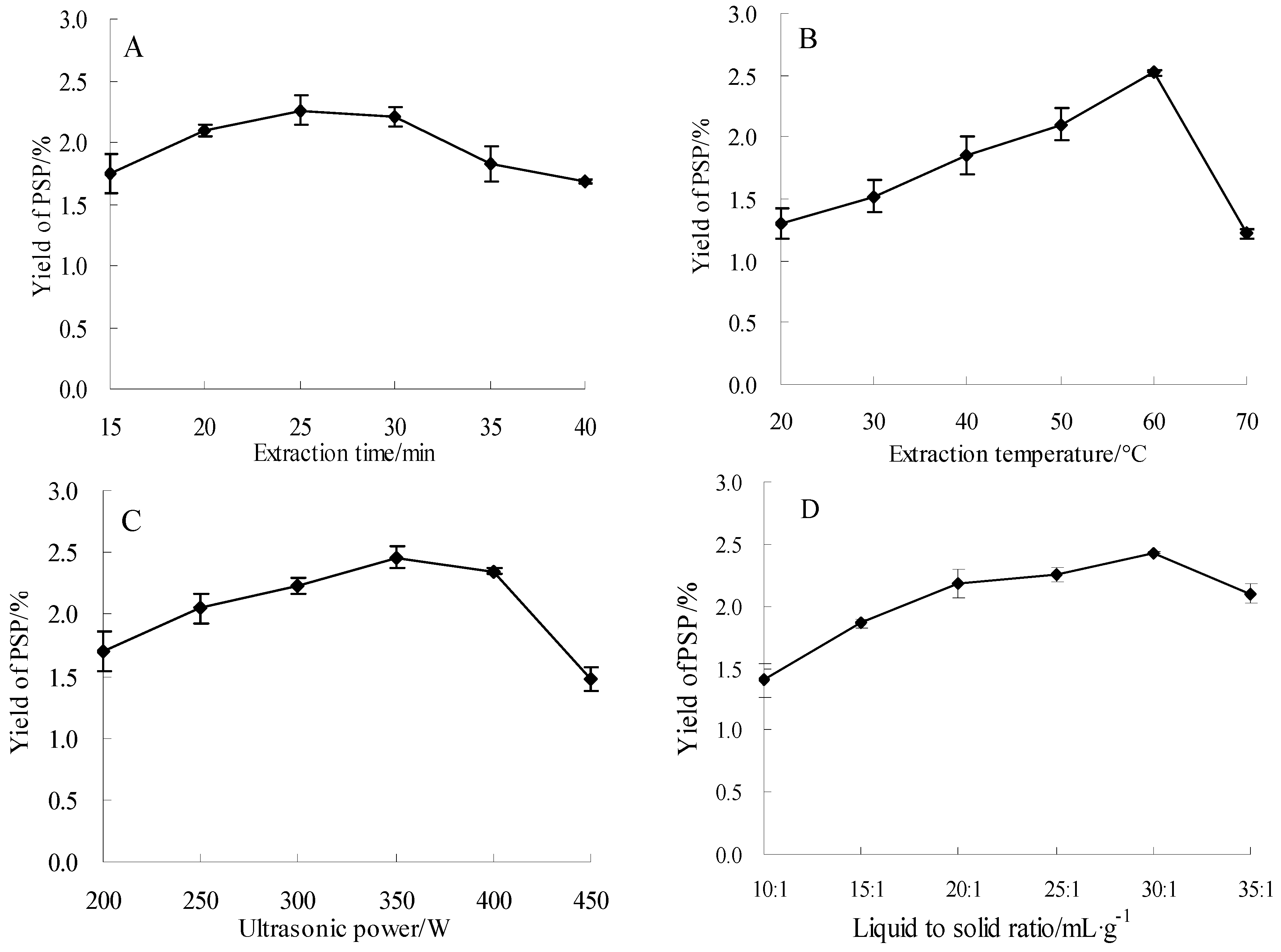
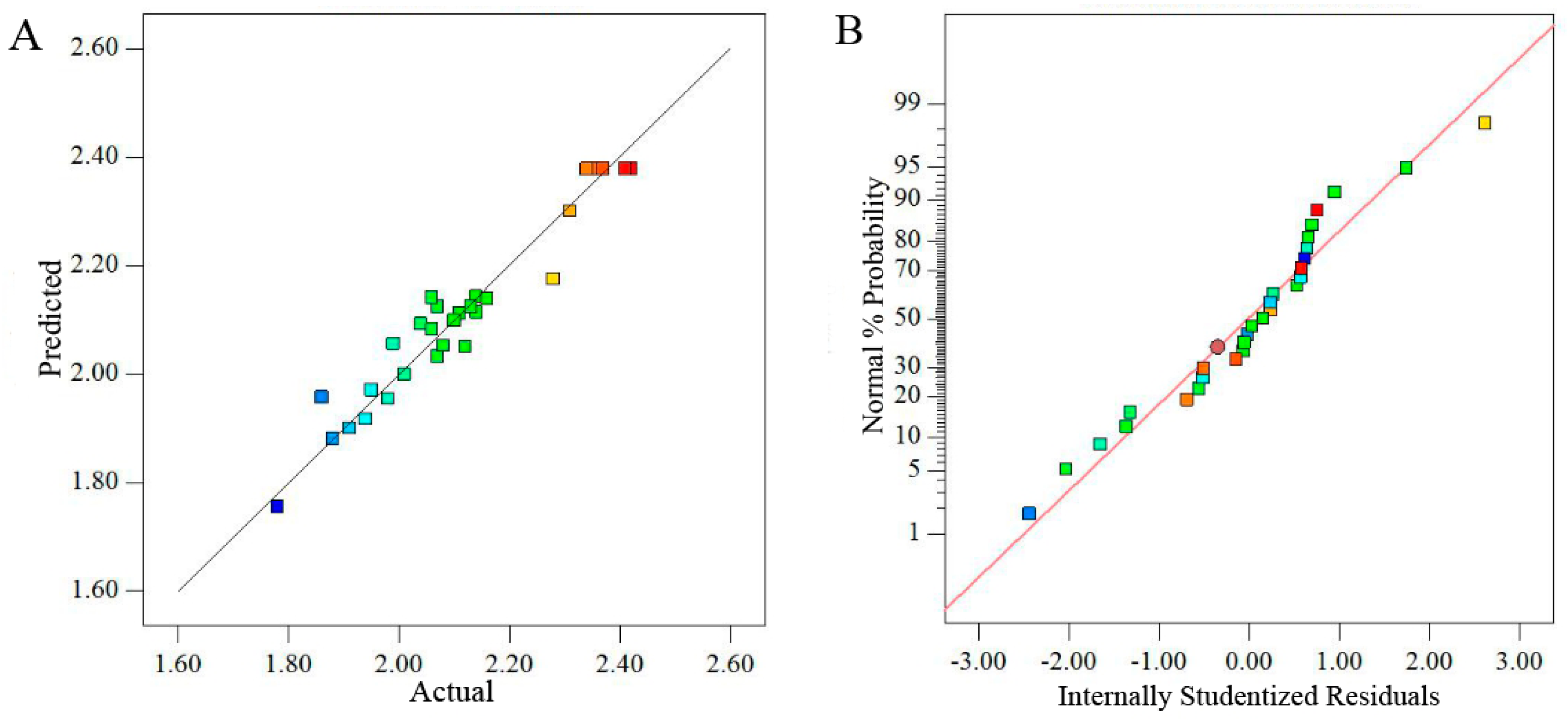
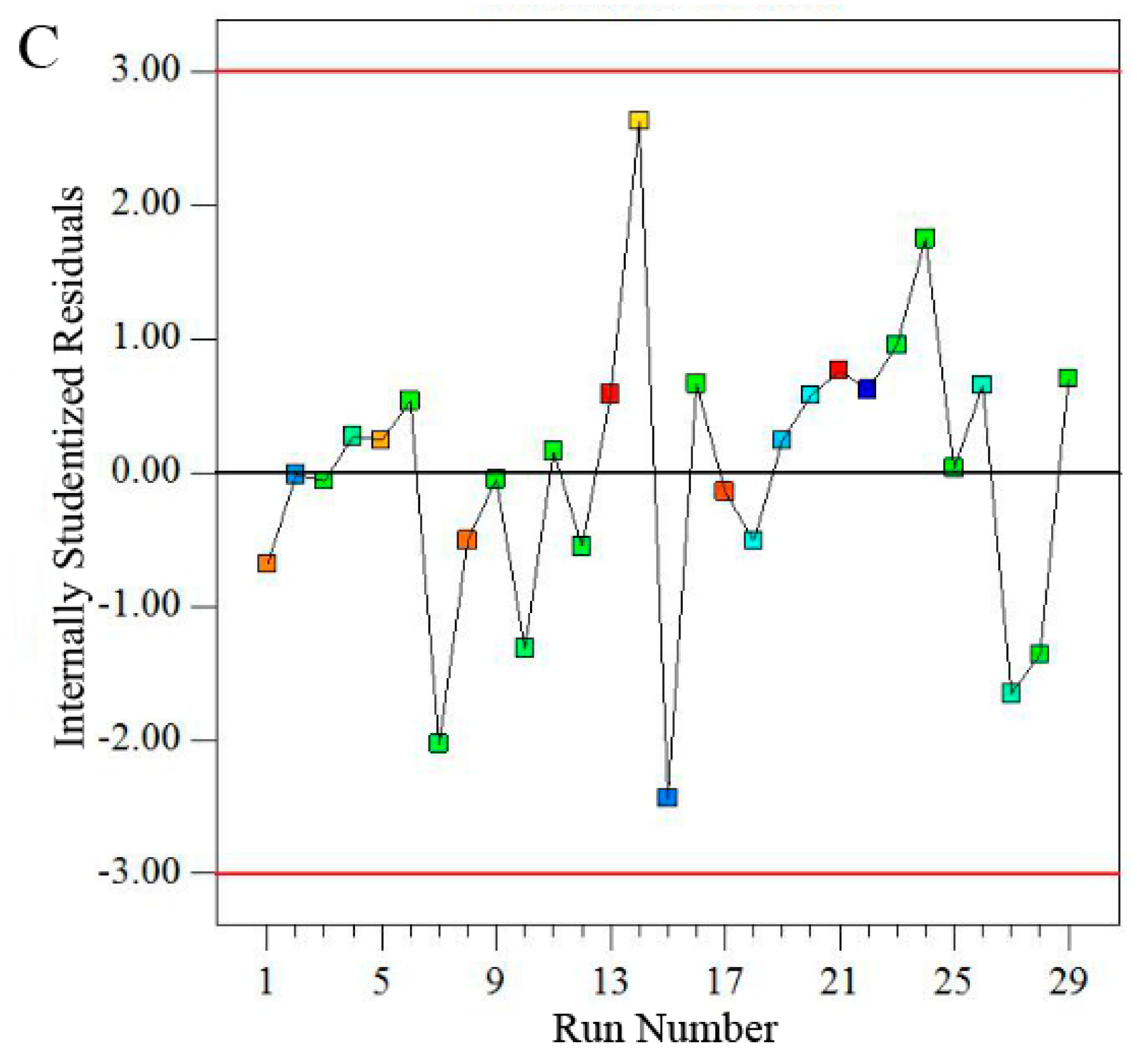
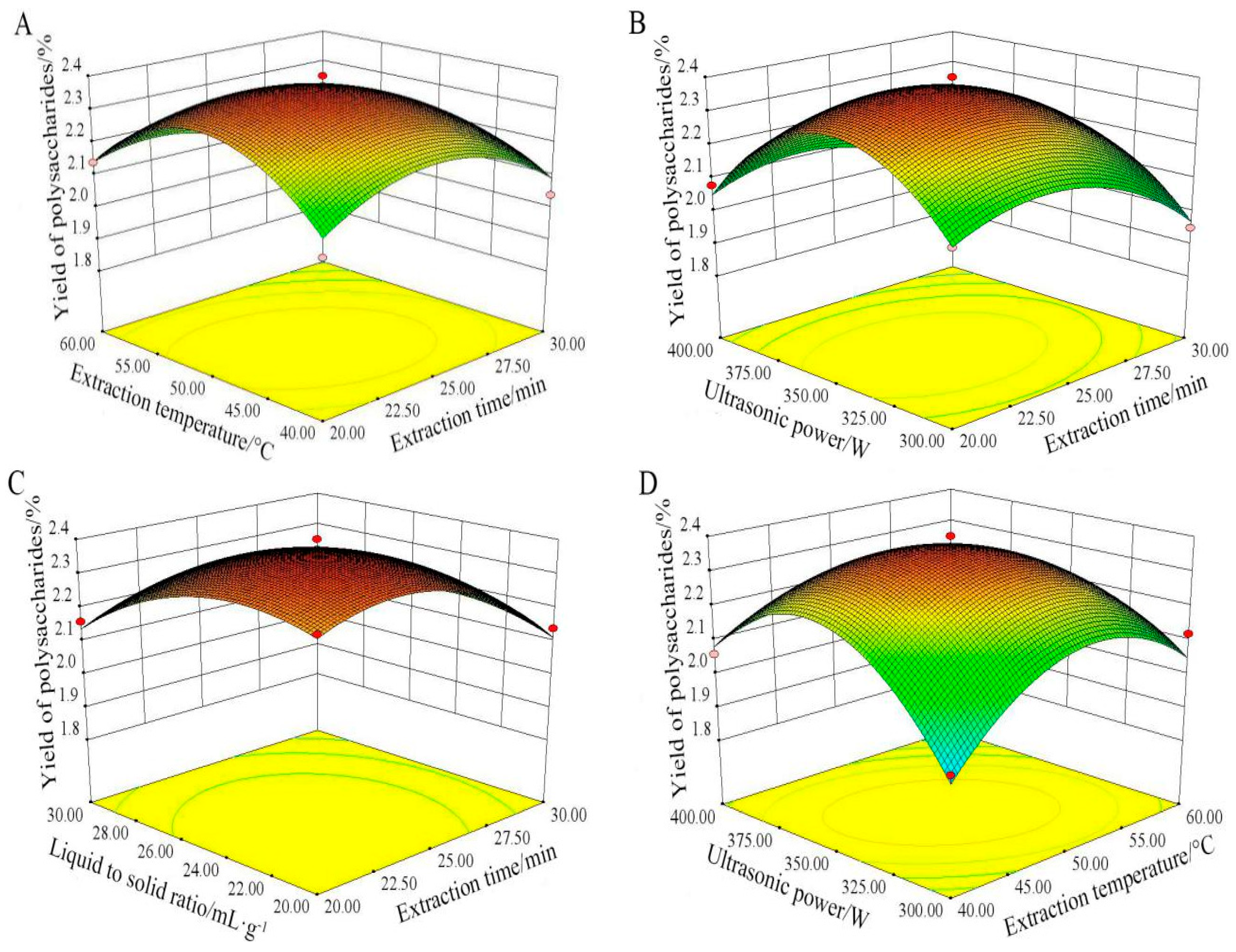


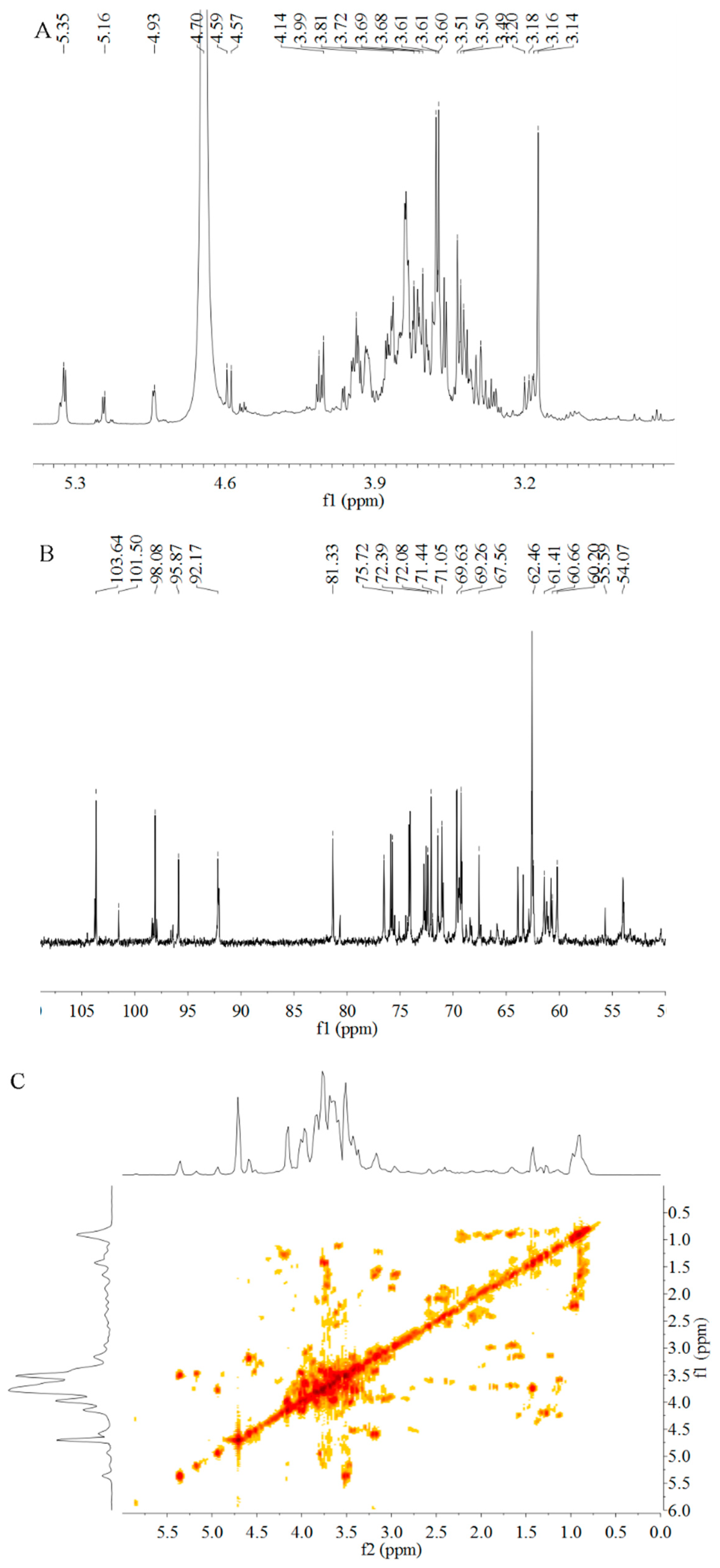
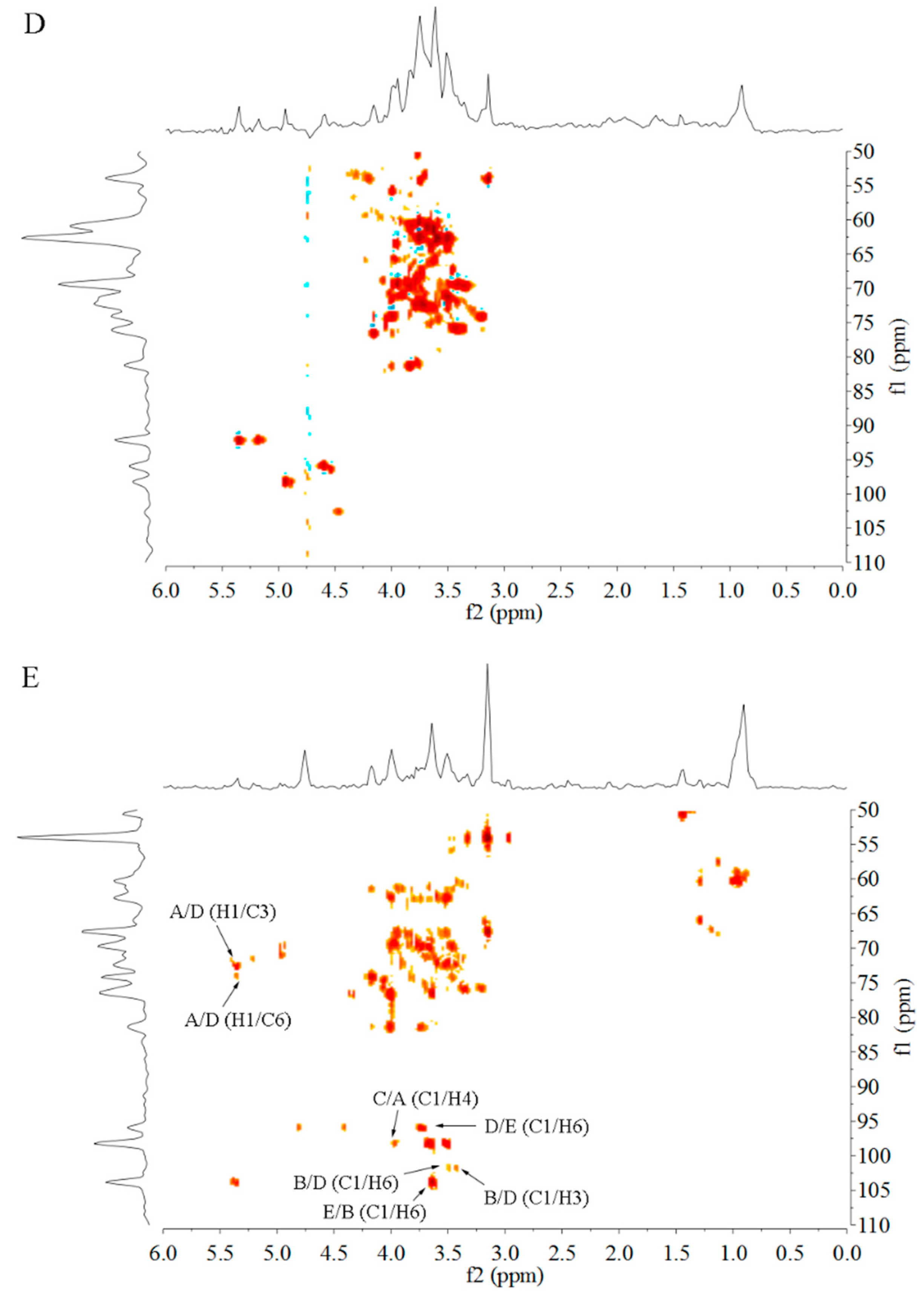

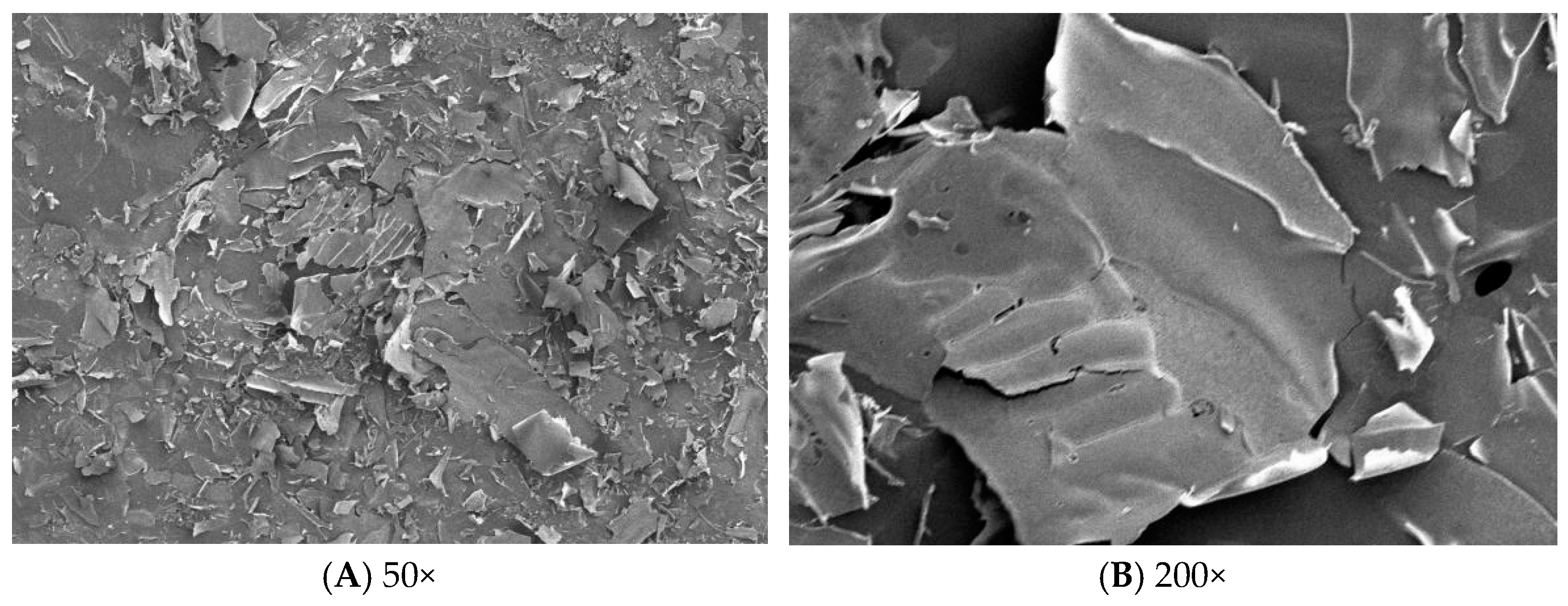
| Number | X1 (Extraction Time, min) | X2 (Extraction Temperature, °C) | X3 (Ultrasonic Power, W) | X4 (Liquid to Solid Ratio, mL/g) | Yield of PSP (%) |
|---|---|---|---|---|---|
| 1 | 0 | 1 | 0 | −1 | 2.13 |
| 2 | 1 | 0 | 0 | −1 | 2.14 |
| 3 | 0 | 0 | −1 | 1 | 2.01 |
| 4 | 1 | −1 | 0 | 0 | 2.04 |
| 5 | 0 | 0 | 0 | 0 | 2.34 |
| 6 | 0 | 0 | 0 | 0 | 2.35 |
| 7 | 0 | 1 | 0 | 1 | 1.86 |
| 8 | 0 | −1 | 0 | −1 | 2.28 |
| 9 | −1 | 1 | 0 | 0 | 2.14 |
| 10 | 0 | 0 | 0 | 0 | 2.41 |
| 11 | 0 | 0 | 1 | 1 | 1.98 |
| 12 | 1 | 1 | 0 | 0 | 1.88 |
| 13 | 0 | 0 | −1 | −1 | 2.06 |
| 14 | 1 | 0 | −1 | 0 | 1.95 |
| 15 | 0 | −1 | −1 | 0 | 1.94 |
| 16 | 0 | 1 | 1 | 0 | 1.78 |
| 17 | 1 | 0 | 0 | 1 | 2.07 |
| 18 | 0 | −1 | 0 | 1 | 2.10 |
| 19 | −1 | 0 | −1 | 0 | 2.11 |
| 20 | 0 | 0 | 0 | 0 | 2.37 |
| 21 | −1 | 0 | 1 | 0 | 2.08 |
| 22 | 0 | 1 | −1 | 0 | 2.12 |
| 23 | 0 | 0 | 0 | 0 | 2.42 |
| 24 | 1 | 0 | 1 | 0 | 1.91 |
| 25 | 0 | 0 | 1 | −1 | 1.99 |
| 26 | −1 | −1 | 0 | 0 | 2.07 |
| 27 | 0 | −1 | 1 | 0 | 2.06 |
| 28 | −1 | 0 | 0 | 1 | 2.16 |
| 29 | −1 | 0 | 0 | −1 | 2.31 |
| Source | Sum of Squares | DF | Mean Square | F-Value | p-Value | Significant |
|---|---|---|---|---|---|---|
| Model | 0.76 | 14 | 0.054 | 14.24 | <0.0001 | ** |
| X1 | 0.065 | 1 | 0.065 | 16.96 | 0.0010 | ** |
| X2 | 0.028 | 1 | 0.028 | 7.37 | 0.0168 | * |
| X3 | 0.013 | 1 | 0.013 | 3.33 | 0.0893 | |
| X4 | 0.044 | 1 | 0.044 | 11.67 | 0.0042 | ** |
| X1X2 | 0.013 | 1 | 0.013 | 3.48 | 0.0833 | |
| X1X3 | 2.500 × 10−5 | 1 | 2.500 × 10−5 | 6.57 × 10−3 | 0.9365 | |
| X1X4 | 1.600 × 10−3 | 1 | 0.0016 | 0.42 | 0.5271 | |
| X2X3 | 0.053 | 1 | 0.053 | 13.91 | 0.0022 | ** |
| X2X4 | 2.025 × 10−3 | 1 | 2.025 × 10−3 | 0.53 | 0.4777 | |
| X3X4 | 4.000 × 10−4 | 1 | 4.000 × 10−3 | 0.11 | 0.7505 | |
| X12 | 0.11 | 1 | 0.11 | 28.93 | <0.0001 | ** |
| X22 | 0.23 | 1 | 0.23 | 60.11 | <0.0001 | ** |
| X32 | 0.37 | 1 | 0.37 | 97.40 | <0.0001 | ** |
| X42 | 0.067 | 1 | 0.067 | 17.57 | 0.0009 | ** |
| Residual | 0.053 | 14 | 3.804 × 10−3 | |||
| Lack of fit | 0.048 | 10 | 4.818 × 10−3 | 3.79 | 0.1053 | |
| Pure error | 5.080 × 10−3 | 4 | 1.270 × 10−3 | |||
| Cor total | 0.81 | 28 | ||||
| CV% | 2.93% | |||||
| R2 | 0.9344 | |||||
| adj-R2 | 0.8688 |
| Sugar Residues | Chemical Shifts, δ 1H/13C (ppm) | |||||
|---|---|---|---|---|---|---|
| 1 | 2 | 3 | 4 | 5 | 6 | |
| A →4)-α-d-Galp-(1→ | 5.35 | 3.65 | 3.36 | 3.84 | 3.41 | 3.61 |
| 92.17 | 75.13 | 69.65 | 81.31 | 68.02 | 62.63 | |
| B →6)-α-d-Glcp-(1→ | 5.16 | 3.99 | 3.90 | 3.52 | 4.06 | 3.62 |
| 101.50 | 72.79 | 76.51 | 71.38 | 76.35 | 65.94 | |
| C α-d-Glcp-(1→ | 4.93 | 3.99 | 3.90 | 3.95 | 3.82 | 3.61 |
| 98.08 | 72.99 | 76.51 | 69.26 | 72.96 | 62.63 | |
| D →3,6)-β-d-Manp-(1→ | 4.59 | 3.81 | 3.50 | 3.54 | 3.60 | 3.43 |
| 95.87 | 66.29 | 72.70 | 72.20 | 71.66 | 75.82 | |
| E →6)-β-d-Galp-(1→ | 4.57 | 3.44 | 3.83 | 4.02 | 3.96 | 3.73 |
| 103.64 | 68.02 | 73.23 | 70.72 | 74.22 | 69.66 | |
| Variables | Coded Variable Levels | ||
|---|---|---|---|
| −1 | 0 | +1 | |
| X1 Extraction time/min | 20 | 25 | 30 |
| X2 Extraction temperature/°C | 40 | 50 | 60 |
| X3 Ultrasonic power/W | 300 | 350 | 400 |
| X4 Liquid to solid ratio/mL·g−1 | 20:1 | 25:1 | 30:1 |
© 2018 by the authors. Licensee MDPI, Basel, Switzerland. This article is an open access article distributed under the terms and conditions of the Creative Commons Attribution (CC BY) license (http://creativecommons.org/licenses/by/4.0/).
Share and Cite
Wang, L.; Cheng, L.; Liu, F.; Li, T.; Yu, Z.; Xu, Y.; Yang, Y. Optimization of Ultrasound-Assisted Extraction and Structural Characterization of the Polysaccharide from Pumpkin (Cucurbita moschata) Seeds. Molecules 2018, 23, 1207. https://doi.org/10.3390/molecules23051207
Wang L, Cheng L, Liu F, Li T, Yu Z, Xu Y, Yang Y. Optimization of Ultrasound-Assisted Extraction and Structural Characterization of the Polysaccharide from Pumpkin (Cucurbita moschata) Seeds. Molecules. 2018; 23(5):1207. https://doi.org/10.3390/molecules23051207
Chicago/Turabian StyleWang, Libo, Long Cheng, Fangcheng Liu, Tengfei Li, Zeyuan Yu, Yaqin Xu, and Yu Yang. 2018. "Optimization of Ultrasound-Assisted Extraction and Structural Characterization of the Polysaccharide from Pumpkin (Cucurbita moschata) Seeds" Molecules 23, no. 5: 1207. https://doi.org/10.3390/molecules23051207
APA StyleWang, L., Cheng, L., Liu, F., Li, T., Yu, Z., Xu, Y., & Yang, Y. (2018). Optimization of Ultrasound-Assisted Extraction and Structural Characterization of the Polysaccharide from Pumpkin (Cucurbita moschata) Seeds. Molecules, 23(5), 1207. https://doi.org/10.3390/molecules23051207





